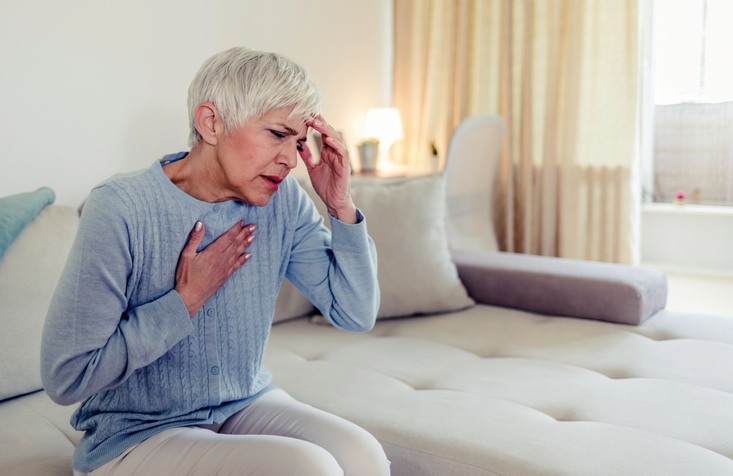10 Warning Signs Of A Stroke – And How To Minimise Risk
80% of strokes occur in women and the risk increases at menopause. Look for the warning signs, and learn what you can do to protect yourself.

The risks for heart disease in women at menopause are often underestimated, particularly by women themselves.
There is a known increase in stroke risk when on HRT, which is why the current guidelines advise women to be on it no longer than 5 years. This is related to an excess of oestrogen, so rebalancing hormones with bioidentical progesterone is essential at menopause if you have oestrogen dominance symptoms.
Progesterone is protective of the heart and it is particularly important for women with a family risk to ensure they have sufficient levels to help reduce their risk.
What is a stroke?
A stroke happens when the blood supply to part of your brain is cut off by a blood clot which blocks the flow of blood to your brain.It can be caused by a blockage in one of the blood vessels leading to the brain or a bleed in the brain itself. Blood carries essential nutrients and oxygen to your brain and without it your brain cells can be damaged or destroyed.
Strokes affect people in different ways, depending on the part of the brain that is affected, how widespread the damage is and how healthy the person was before the stroke.
It can affect the way your body functions as well as thought processes and how you feel and communicate. The latter means it can also have an emotional impact and may cause problems such as anxiety, depression or changes to your personality.
Risk factors and warning signs
HRT and other synthetic hormone products such as the Pill or Coil are not the only risk factor. Medical problems like diabetes, high blood pressure, being overweight and high cholesterol can increase your risk of having a stroke – and these conditions can increase at menopause.
Lifestyle factors, such as diet, drinking alcohol, taking drugs, smoking and how active you are, can also increase your risk.
Luckily, a stroke can be treated, but getting emergency medical attention as quickly as possible is the key to survival. That’s why it’s vital to recognize the following ten warning signs.
1. Loss of Balance
Look for if they have trouble walking, lose their balance and coordination completely, and even have trouble sitting down without falling.
2. Weakness
Look for a sudden loss of strength in the muscles of the face, arm, leg because even if it’s just temporary it can signal an oncoming stroke. There may be numbness or tingling in the left arm or shoulder that comes on suddenly and gradually worsens.
Sometimes, complete muscle failure can occur, where you can’t lift an arm or bear weight on the affected leg.
3. Facial Paralysis
Look for a change in the facial muscles, where one side of the face droops or goes totally numb so the face appears non symmetrical when they try to talk or smile.
4. Difficult Speech
Look for a sudden difficulty in speaking or forming intelligent sentences, or a look of sudden confusion on the affected person’s face.
5. Impaired Vision
Look for any mention of trouble seeing or seeing clearly. This blurred vision might only be temporary, but observers can test it by asking the victim how many fingers they are holding up. If they can’t tell, call an ambulance.
6. Lack of Understanding
Look for difficulty understanding certain statements and/or commands in the days leading up to the actual stroke.
7. Headache
Look for the sudden onset of a severe, debilitating headache or migraine that is not normal or usual. Many stroke victims experience a headache so painful that it feels like being struck by lightning, causes extreme nausea, and even collapse.
8. Loss of Sensation
Look for a gradual, or even a total, loss of sensation or feeling on the skin in the days leading up to a stroke. The other senses — such as smell, taste, and hearing can also be fully or partially affected.
9. Dizziness
Look for a total loss of balance so severe that they feel like the world is spinning, as with vertigo.
10. Lack of Reflex
Look for a decrease or loss of reflex. For instance, many stroke victims complain of trouble swallowing when eating to the point where they gag.
How can you reduce that risk?
As well as ensuring you have sufficient bioidentical progesterone levels to protect your heart, new research suggests that women who eat higher amounts of potassium-containing foods are less prone to having a stroke that results in death than those who eat fewer, according a study published in the American Heart Association’s journal Stroke.
If you are not sure you are getting enough magnesium, then it is back to our old healthy diet favourites so include these as often as you can: bananas, dark leafy greens such as spinach, baked potatoes with skin, and dried apricots.
Also plain non-fat yogurt, salmon, avocados and mushrooms offer abundant sources of potassium.
Just not sure what your progesterone and oestrogen levels are? This article can help:
https://anna.blog.wellsprings-health.com/what-signs-of-oestrogen-dominance-do-you-have-3/


















